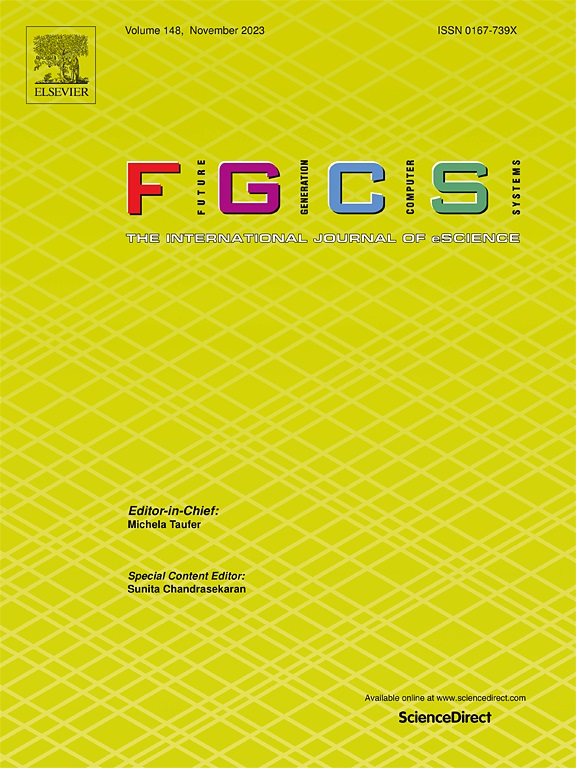迈向可持续的智慧城市:在健康物云(CoHT)中使用深度强化学习和蛾焰优化边缘云系统的工作流调度
IF 6.2
2区 计算机科学
Q1 COMPUTER SCIENCE, THEORY & METHODS
Future Generation Computer Systems-The International Journal of Escience
Pub Date : 2025-03-26
DOI:10.1016/j.future.2025.107821
引用次数: 0
摘要
在智慧城市中,健康物云(CoHT)增强了服务交付,优化了任务调度和分配。随着CoHT系统的激增并提供一系列具有不同服务质量(QoS)要求的服务,服务器面临着在基于internet的应用程序之间有效分配有限虚拟机的挑战。这可能会导致性能紧张,特别是对于对延迟敏感的医疗保健应用程序,从而导致延迟增加。边缘计算通过使计算、存储和网络资源更接近数据源,并与云计算协同工作,缓解了这一问题。结合边缘计算和云计算对于提高效率至关重要,特别是对于可靠性和低延迟至关重要的物联网驱动任务。本文介绍了一种利用飞蛾火焰优化(MFO)算法和深度强化学习(DRL)相结合的智能任务调度和分配模型,以优化可持续智慧城市中的边缘云计算。该模型利用双类神经网络对任务进行分类,保证快速收敛,同时提供局部和全局最优解,实现有效的资源分配,增强QoS。该模型在现实世界和合成的集群数据集上进行训练,包括谷歌集群数据集,以学习基于云的作业调度,然后实时应用。与DRL和非DRL方法相比,该模型显示出显著的性能提升,延迟降低76.2%,可靠性提高81.9%,资源利用率提高74.4%,QoS提高83.1%。本文章由计算机程序翻译,如有差异,请以英文原文为准。
Towards sustainable smart cities: Workflow scheduling in cloud of health things (CoHT) using deep reinforcement learning and moth flame optimization for edge–cloud systems
In smart cities, the Cloud of Health Things (CoHT) enhances service delivery and optimizes task scheduling and allocation. As CoHT systems proliferate and offer a range of services with varying Quality of Service (QoS) demands, servers face the challenge of efficiently distributing limited virtual machines across internet-based applications. This can strain performance, particularly for latency-sensitive healthcare applications, resulting in increased delays. Edge computing mitigates this issue by bringing computational, storage, and network resources closer to the data source, working in tandem with cloud computing. Combining edge and cloud computing is essential for improving efficiency, especially for IoT-driven tasks where reliability and low latency are vital concerns. This paper introduces an intelligent task scheduling and allocation model that leverages the Moth Flame Optimization (MFO) algorithm, integrated with deep reinforcement learning (DRL), to optimize edge–cloud computing in sustainable smart cities. The model utilizes a bi-class neural network to classify tasks, ensuring rapid convergence while delivering both local and globally optimal solutions, achieving efficient resource allocation, and enhancing QoS. The model was trained on real-world and synthesized cluster datasets, including the Google cluster dataset, to learn cloud-based job scheduling, which is then applied in real-time. Compared with DRL and non-DRL approaches, the model shows significant performance gains, with a 76.2% reduction in latency, an 81.9% increase in reliability, a 74.4% improvement in resource utilization, and an 83.1% enhancement in QoS.
求助全文
通过发布文献求助,成功后即可免费获取论文全文。
去求助
来源期刊
CiteScore
19.90
自引率
2.70%
发文量
376
审稿时长
10.6 months
期刊介绍:
Computing infrastructures and systems are constantly evolving, resulting in increasingly complex and collaborative scientific applications. To cope with these advancements, there is a growing need for collaborative tools that can effectively map, control, and execute these applications.
Furthermore, with the explosion of Big Data, there is a requirement for innovative methods and infrastructures to collect, analyze, and derive meaningful insights from the vast amount of data generated. This necessitates the integration of computational and storage capabilities, databases, sensors, and human collaboration.
Future Generation Computer Systems aims to pioneer advancements in distributed systems, collaborative environments, high-performance computing, and Big Data analytics. It strives to stay at the forefront of developments in grids, clouds, and the Internet of Things (IoT) to effectively address the challenges posed by these wide-area, fully distributed sensing and computing systems.

 求助内容:
求助内容: 应助结果提醒方式:
应助结果提醒方式:


